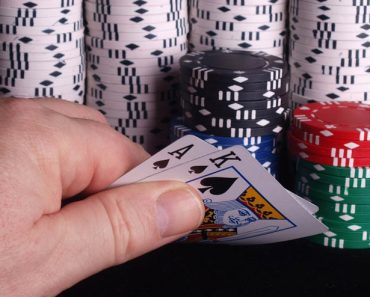Positional awareness is one of the most important strategic skills you’ll need to develop in poker. Understanding how your game plan changes depending on the position is essential to your long-term success. In this particular article, we’ll focus on playing from Under the Gun, or UTG.
Here's a high-level overview of UTG and how to play from this position:
UTG is seated to the left of the big blind and is the first player to act. To compensate for the lack of information when opening first, you should stick to a tight range of strong hands, including high-pocket pairs, suited aces, and suited broadway hands, to maximize your chances of winning the pot.
There is a lot to learn about how to play under the gun, but your fundamental approach to this position should be very solid and straightforward. Stick to playing very good starting hands only and avoid any fancy tricks. These are much better suited for later positions, like the cutoff or button.
The Trouble of Playing from Under the Gun
When you’re the one starting the action in a poker hand, you have absolutely no idea about any of your opponents’ holdings or their plans. Poker is a game of limited information in general, but when you’re UTG, you have no information whatsoever.
The only thing you do know for certain is that there are eight (or five, if you’re playing 6-max) players to act behind you.
The likelihood of at least one player out of eight having a (very) good hand is quite high. Of course, it can also happen that everyone was dealt trash hands and will be happy to fold and concede the pot, but you simply don’t know.
Another main issue of playing from under the gun is the positional disadvantage. If you get called or 3-bet by anyone other than blinds, you’ll have to play the rest of the hand out of position. As you probably know, this is not ideal.
So, to sum it up, the biggest problems of playing from UTG in poker are the lack of information and the positional disadvantage that you can easily find yourself in.
Structuring Your UTG Hand Selection
The first thing you need to do to develop a solid UTG strategy is figuring out the range of hands you should play. I have good news and the bad news here.
The good news is, you won’t have a hard time remembering your UTG hand ranges. The bad news is, you really can’t afford to play too many hands from this position. You have to be quite tight, especially if you’re in a game with competent players.
You should primarily sticking to playing very strong hands – pocket pairs down to pocket 8s, the strongest of your unsuited aces (AK, AQ), good suited aces (AK, AQ, AJ, and AT), and suited broadway cards like KQs and KJs.
With some experience and to avoid becoming too predictable, you can also include some weaker hands, such as TJs, TKs, smaller pocket pairs, and maybe T9s. However, this doesn’t mean you’ll play these hands every time you get them under the gun. You should usually fold them, and then sometimes raise with them to keep your range somewhat balanced.
You shouldn’t be overly concerned about balancing your UTG ranges, though.
Due to the nature of this position, it’s natural you’ll mostly have very strong hands when you come in for a raise. It may feel a bit transparent, but, unlike in late positions, you don’t have to worry about this too much. UTG will never be your most profitable position, and that’s fine.
Playing UTG in 6-Max
If you’re playing short-handed, i.e. in 6-max games, your UTG ranges will generally be wider. Since you don’t have to go through that many players and there are only three players that can potentially have position over you after the flop, you don’t have to be as tight.
You can expand by adding more suited aces, down to A8s, unsuited aces down to AT, and pocket pairs down to 55. You can also add a few more suited connectors and small suited aces (A2 through A5) occasionally to achieve better balance.
You still shouldn’t go too crazy, but in short-handed games, playing under the gun isn’t as big of a disadvantage as it is in full ring.
Under the Gun Strategy: Tournaments vs. Cash Games
Tournaments and cash games are two completely different forms of poker. While some strategies are interchangeable between the two, there are many aspects that are quite different. Playing from UTG is definitely one of them.
In cash games, you’re usually going to play deeper. With a stack of 100 big blinds or more, you can afford to try and get involved in more hands. You can always reload as well, so you have some freedom to experiment with wider UTG ranges. This may not be the best idea, but if you’re trying to get the feel for the table and perhaps utilize some exploitative plays, there can be some merit to it.
In tournaments, though, you’ll hardly ever have a big enough stack to afford such adventures.
If you have between 20 and 40 big blinds, you really can’t afford to open wide ranges from under the gun. Very often, you’ll be met by resistance and forced to fold, and you could lose half of your chips without even seeing a flop.
In tournaments, your UTG strategy should be very conservative. Stick to playing good hands only, especially as your stack gets shorter. Try to open only with hands that you’ll be happy to play with the stacks for.
Again, this may seem like too weak or transparent, but don’t worry about it. You’ll have plenty of other positions you can use to open wider from and try to steal the pot.
Playing Before the Flop
When you open from under the gun, the rarest scenario that will happen is that everyone folds and you pick up the blinds, especially in full ring games. You’ll usually be met with some resistance by at least one player.
If they just call, you’ll proceed to the flop, which we’ll cover in the next section. But, what happens if they 3-bet?
Your decision on how to proceed will depend on two main factors:
- How good your hand is, and
- What position the 3-bettor is (in the blinds or not)?
The first one is self-explanatory. If you’re faced with a 3-bet, you should probably fold the weaker hands from your UTG range and only continue with the strongest ones.
How you decide to proceed with the stronger part of your range is, again, dependent on the opponent and your table image. Sometimes you’ll want to 4-bet and get the chips in the middle; sometimes you’ll be better off calling, even with your strongest hands like AA and KK to trap your opponent and perhaps give them a chance to keep bluffing.
The second part is just as important. If you’re 3-bet by one of the players in the blinds, there are two things to think about.
First of all, you will have the position after the flop. This means that you might call with a wider range to try and hit a favorable flop. Since you have the position, it’ll be much easier to realize your equity when you do hit.
On the other hand, if the player you’re up against is competent, they aren’t very likely to 3-bet you light from the blinds. They know you're under the gun range is strong, and they are aware they’ll be out of position for the rest of the hand. Based on that, you can expect them to show up with some very strong holdings in these situations.
These things get more and more complex as the level of players you play against improves. A recreational player may feel like they need to 3-bet their 56s in the small blind against your UTG raise because they want to “juice up” the pot and they have a good feeling about their hand.
A good player will never do this. They might have some (albeit very few) bluffs in their range, but don’t count too much on it.
UTG Strategy After the Flop
When you raise UTG and get to the flop, it’ll usually be one of the two scenarios. Either you raised and picked up one or more callers, or another player 3-bet and you decided to call and see the flop.
Playing UTG Against Callers
Usually, when players just flat your raise, they won’t show up with a monster. Every now and again you might run into pocket Aces, but they’ll generally want to 3-bet their strong hands as they expect you have a decent hand yourself so they can get you to commit more chips preflop.
So, in some ways, their range will be capped, i.e. they won’t have many super strong hands.
Whether you connect with the board or not, you’ll want to continue on flops that favor your opening range, i.e. boards containing high cards and especially Aces. Even if you’re out of position, it will be very hard for your opponents to float you on these types of boards to try and bluff you later.
On the other hand, certain boards just aren’t good candidates to continuation bet on. If the board comes something like 8 9 T, two-tone, it’s much better for the calling range. They’ll have all the suited JT, QJ, and 9T-type of hands.
This is why it’s good to also have some non-premiums in your UTG range so that you can still keep playing on these textures and surprise your opponents with an occasional flopped monster where they just can’t put you on one.
That said, don’t get too involved on these boards if you don’t have a strong hand and exercise caution even when you do have a preflop premium like Kings or Aces. It’s not just that the flop is bad for you; there are many turn and river cards that you’re going to hate, so keep that in mind as well and try to exercise pot control.
Playing in 3-bet Pots
When someone 3-bets your UTG open, they’re pretty much telling you they have a very strong hand. It may not be true, but that’s the kind of story their 3-bet is trying to convey.
As already mentioned, it’s much harder to deal with 3-bets coming from players that will have the position on you after the flop. They have everything going on for them: the advantage of the position, the initiative, and they’re representing a strong hand.
It would be well beyond the scope of this article to go into all the intricacies of 3-bet pots in these scenarios, so we’ll just stick to the basics.
If you don’t have a very strong hand, i.e. AJs or better, and get 3-bet by someone in position, just fold and move on with your life. If they are super-aggressive and do it all the time, you might need to adjust, but against an average, solid player, you really don’t need to get to involved with these trouble hands like weaker Aces and broadways.
With your strong hands, it’s fine to sometimes see the flop instead of 4-betting. Keep in mind that you aren’t doing this just to save yourself from running into monsters. You’re also doing it so that your opponents know you’re capable of it. When you flat their 3-bet, they can’t automatically put you on the weaker part of your range. You could still have a hand like Aces or AKs.
On the flop, check to them and let them continue telling their story. Depending on how well you connect with the flop, stack-to-pot ratio, and your reads, you can then decide whether you want to call, fold, or raise their continuation bet.
The important thing to remember is that generally, you should allow the 3-bettor to keep the aggression. This will allow them to bluff away some more chips or maybe commit themselves to a pot so that they can’t get away once you pull the trigger and raise.
Playing Under the Gun in Poker: Summary
Having to play from under the gun isn’t the most pleasant thing in poker, but it’s something you’ll simply have to deal with. As long as you accept the reality of the situation and understand that you can’t play 50% of your hands from UTG, you should be fine.
Stick to playing very strong hands for the most part and try to avoid getting yourself into trouble with weak hands. There is very little anyone can do to exploit you if you’re applying this strategy. They may know that your UTG range is very strong, but it’s still not easy to out-flop you or bluff you off your premium holdings.
So, if you’ve had problems playing from under the gun before, this article should provide you with some useful, hands-on tips you can incorporate into your play. Tighten your ranges, don’t be afraid to play your big hands fast, and forget about fancy tricks and big bluffs from this particular position, and you should be much better off.







